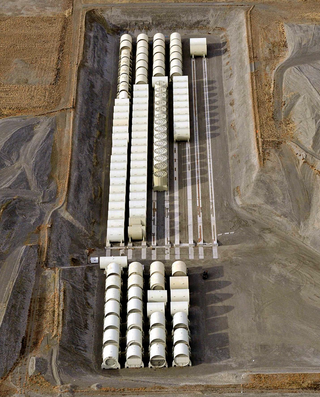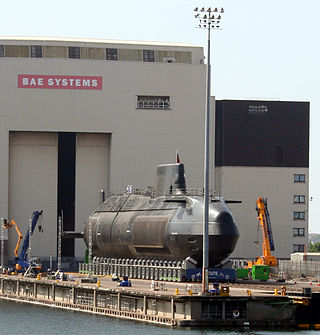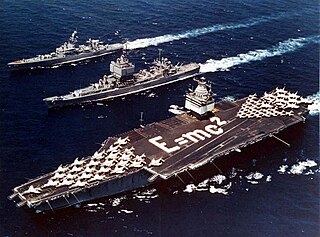Related Research Articles
The Ship-Submarine Recycling Program (SRP) is the process that the United States Navy uses to dispose of decommissioned nuclear vessels. SRP takes place only at the Puget Sound Naval Shipyard (PSNS) in Bremerton, Washington, but the preparations can begin elsewhere.

United States naval reactors are nuclear reactors used by the United States Navy aboard certain ships to generate the steam used to produce power for propulsion, electric power, catapulting airplanes in aircraft carriers, and a few more minor uses. Such naval nuclear reactors have a complete power plant associated with them. All commissioned U.S. Navy submarines and supercarriers built since 1975 are nuclear powered, with the last conventional carrier, USS Kitty Hawk, being decommissioned in May 2009. The U.S. Navy also had nine nuclear-powered cruisers with such reactors, but they have since been decommissioned as well.
The S1G reactor is a naval reactor used by the United States Navy to provide electricity generation and propulsion on warships. The S1G designation stands for:

USS Seawolf (SSN-575) was the third ship of the United States Navy to be named for the seawolf, the second nuclear submarine, and the only US submarine built with a liquid metal cooled (sodium), beryllium-moderated nuclear reactor, the S2G. Her overall design was a variant of Nautilus, but with numerous detail changes, such as a conning tower, stepped sail, and the BQR-4 passive sonar mounted in the top portion of the bow instead of further below. This sonar arrangement resulted in an unusual bow shape above the water for a U.S. submarine. Originally laid down in 1953, her distinctive reactor was later replaced with a standard pressurized water reactor, the replacement process lasting from 12 December 1958 to 30 September 1960.

USS Triton (SSRN/SSN-586), the only member of her class, was a nuclear powered radar picket submarine in the United States Navy. She had the distinction of being the only Western submarine powered by two nuclear reactors. Triton was the second submarine and the fourth vessel of the United States Navy to be named for the Greek god Triton, At the time of her commissioning in 1959, Triton was the largest, most powerful, and most expensive submarine ever built at $109 million excluding the cost of nuclear fuel and reactors.

A nuclear submarine is a submarine powered by a nuclear reactor, but not necessarily nuclear-armed. Nuclear submarines have considerable performance advantages over "conventional" submarines. Nuclear propulsion, being completely independent of air, frees the submarine from the need to surface frequently, as is necessary for conventional submarines. The large amount of power generated by a nuclear reactor allows nuclear submarines to operate at high speed for long periods, and the long interval between refuelings grants a range virtually unlimited, making the only limits on voyage times being imposed by such factors as the need to restock food or other consumables.

Nuclear marine propulsion is propulsion of a ship or submarine with heat provided by a nuclear reactor. The power plant heats water to produce steam for a turbine used to turn the ship's propeller through a gearbox or through an electric generator and motor. Nuclear propulsion is used primarily within naval warships such as nuclear submarines and supercarriers. A small number of experimental civil nuclear ships have been built.
A nuclear navy, or nuclear-powered navy, refers to the portion of a navy consisting of naval ships powered by nuclear marine propulsion. The concept was revolutionary for naval warfare when first proposed. Prior to nuclear power, submarines were powered by diesel engines and could only submerge through the use of batteries. In order for these submarines to run their diesel engines and charge their batteries they would have to surface or snorkel. The use of nuclear power allowed these submarines to become true submersibles and unlike their conventional counterparts, they became limited only by crew endurance and supplies.
The names of commissioned ships of the United States Navy all start with USS, for United States Ship. Non-commissioned, primarily civilian-crewed vessels of the U.S. Navy under the Military Sealift Command have names that begin with USNS, standing for United States Naval Ship. A letter-based hull classification symbol is used to designate a vessel's type. The names of ships are selected by the Secretary of the Navy. The names are those of states, cities, towns, important persons, important locations, famous battles, fish, and ideals. Usually, different types of ships have names originated from different types of sources.
There are three major types of submarines in the United States Navy: ballistic missile submarines, attack submarines, and cruise missile submarines. All submarines currently in the U.S. Navy are nuclear-powered. Ballistic missile submarines have a single strategic mission of carrying nuclear submarine-launched ballistic missiles. Attack submarines have several tactical missions, including sinking ships and subs, launching cruise missiles, and gathering intelligence. Cruise missile submarines perform many of the same missions as attack submarines, but with a focus on their ability to carry and launch larger quantities of cruise missiles than typical attack submarines.

An SSN is a nuclear-powered general-purpose attack submarine. SSN is the US Navy hull classification symbol for such vessels; the SS denotes a submarine and the N denotes nuclear power. The designation SSN is used for interoperability throughout NATO under STANAG 1166, though navies use other terms.

Machinist's mate is a rating in the United States Navy's engineering community.

The S2G reactor was a naval reactor used by the United States Navy to provide electricity generation and propulsion on warships, and the only liquid metal cooled reactor yet deployed by the US Navy. The S2G designation stands for:
The S2W reactor was a naval reactor used by the United States Navy to provide electricity generation and propulsion on warships. The S2W designation stands for:

The S6W reactor is a naval reactor used by the United States Navy to provide electricity generation and propulsion on warships. The S6W designation stands for:
United States ship naming conventions for the U.S. Navy were established by congressional action at least as early as 1862. Title 13, section 1531, of the U.S. Code, enacted in that year, reads, in part,
The vessels of the Navy shall be named by the Secretary of the Navy under direction of the President according to the following rule: Sailing-vessels of the first class shall be named after the States of the Union, those of the second class after the rivers, those of the third class after the principal cities and towns and those of the fourth class as the President may direct.
In the United States Navy, Refueling and Overhaul (ROH) refers to a lengthy refitting process or procedure performed on nuclear-powered naval ships, which involves replacement of expended nuclear fuel with new fuel and a general maintenance fix-up, renovation, and often modernization of the entire ship. In theory, such a process could simply involve only refueling or only an overhaul, but in practice, nuclear refueling is always combined with an overhaul. An ROH usually takes one to two years for submarines and up to almost three years for an aircraft carrier, performed at a naval shipyard. Time periods between ROHs on a ship have varied historically from about 5–20 years (for submarines) to up to 25 years (for Nimitz-class aircraft carriers). For modern submarines and aircraft carriers, ROHs are typically carried out about midway through their operating lifespan. There are also shorter maintenance fix-ups called availabilities for ships periodically at shipyards. A particularly lengthy refueling, maintenance, and modernization process for a nuclear aircraft carrier can last up to almost three years and be referred to as a Refueling and Complex Overhaul (RCOH).

Nuclear Power School (NPS) is a technical school operated by the U.S. Navy in Goose Creek, South Carolina as a central part of a program that trains enlisted sailors, officers, KAPL civilians and Bettis civilians for shipboard nuclear power plant operation and maintenance of surface ships and submarines in the U.S. nuclear navy. As of 2020 the United States Navy operates 98 nuclear power plants, including 71 submarines, 11 aircraft carriers, two Moored Training Ships (MTS) and two land-based training plants. NPS is the centerpiece of the training pipeline for U.S. Navy nuclear operators. It follows initial training at Nuclear Field "A" School or a college degree, and culminates with certification as a nuclear operator at one of the Navy's two Nuclear Power Training Units (NPTU).
The United States Navy Nuclear Propulsion community consists of Naval Officers and Enlisted members who are specially trained to run and maintain the nuclear reactors that power the submarines and aircraft carriers of the United States Navy. Operating more than 80 nuclear-powered ships, the United States Navy is currently the largest naval force in the world.

In the early 1960s, the United States Navy was the world's first to have nuclear-powered cruisers as part of its fleet. The first such ship was USS Long Beach (CGN-9). Commissioned in late summer 1961, she was the world's first nuclear-powered surface combatant. She was followed a year later by USS Bainbridge (DLGN-25). While Long Beach was a 'true cruiser', meaning she was designed and built as a cruiser, Bainbridge began life as a frigate, though at that time the Navy was using the hull code "DLGN" for "destroyer leader, guided missile, nuclear". This was prior to the enactment of the 1975 ship reclassification plan, in which frigates (DLG/DLGN), which were essentially large destroyers, were reclassified as cruisers, so that the US Navy's numbers would compete with those of the Soviet Navy. Long Beach, the largest of all the nuclear cruisers, was equipped with a C1W cruiser reactor, while all the others were equipped with D2G destroyer reactors.
References
- US Navy Propulsion Systems – Federation of American Scientists
- Nuclear Attack Submarines – CombatIndex.com